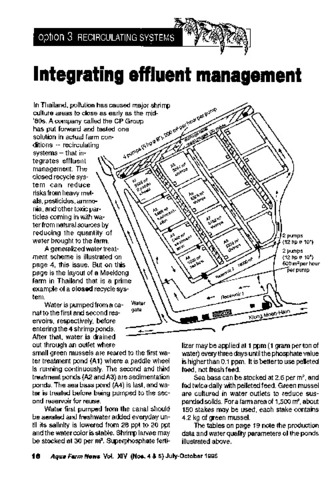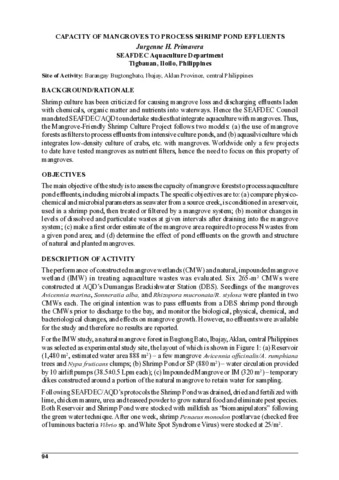Hi-density tank culture of Nile tilapia (Oreochromis niloticus) using lake water with effluent management
- Global styles
- MLA
- Vancouver
- Elsevier - Harvard
- APA
- Help
Share
Abstract
Nine concrete tanks (2 x 2 x 1 m) were stocked with tilapia fingerlings (abw = 3.3±0.9 g) and three stocking rates (50 fish/m2, 100/m2, and 150/m2) were tried. The rearing period lasted for 120 days. Fingerlings were fed commercial diet containing approximately 27% crude protein. The amount of feed was adjusted based on monthly weight samplings. Pre-filtered lake water pumped through gravity aerators into the tanks was used throughout the culture period. Although production was intensified, water agitators and similar mechanical implements were not employed to cut production costs.
Results show that tilapia stocked at 50/m3 grew significantly heavier at 109.2 ± 8.0 g. This was significantly better (P<0.05) than fish stocked at 100 and 150/m3, which had basically the same final weight of 82.4 ± 1.8 g and 83.4 ± 8.7 g, respectively. Likewise, survival or recovery at harvest was highest at 92.8% for the stocking rate of 50 fish/m3. The results suggest that stocking at lower densities would result to bigger fish but a lower total yield per tank, or higher stocking densities would mean higher yield but smaller individual fish size at harvest. The rate of water flow through at harvest time was equivalent to 0.30 L/min/kg biomass at the highest stocking density of 150/m3, 0.40 L/min/kg biomass at 100/m3, and 0.60 L/min/kg biomass at the lowest density of 50/m3. Siddiqui et al. (1991) suggested a minimum of 0.50 L/min/kg biomass flow rate for intensive culture of tilapia, but this was generally for clean culture water, not like lake water whose quality varies naturally.
After determining the optimum stocking density, a second experiment using bigger fingerlings (57.5±12.6 g) was conducted for 101 days to determine the ideal water flow rate in the system. Varying flow rates (10 liters per minute (Lpm), 15 Lpm and 20 Lpm) were evaluated at a fixed stocking density of 50 fish/m3. Feed ration was 5% during the first two months, 4% on the third month, and 3% thereafter. Tilapia size at harvest increased with increasing flow rate when stocked at 50 fish/m3. From an initial stocking size of 57.5 ± 12.6 g, biggest fish harvests were obtained in tanks with a flow through rate of 20 Lpm (152.2 ± 15.1 g) after 101 days of culture. However, this was not significantly different to fish grown in tanks at 15 Lpm (139.9 ± 7.6 g). Smallest fish harvests were obtained at 10 Lpm at 111.20 ± 8.3 mm. A similar trend was observed with fish length at 157.7 ± 15.5 mm, 150.8 ± 11.0 mm, and 142.1±17.6 mm for 20 Lpm, 15 Lpm, and 10 Lpm, respectively. Feed conversion ratio (FCR) ranged from 1.7 to 2.5 in all treatments. The rate of water flow through at harvest time was equivalent to 1.2 L/min/kg biomass at 20 Lpm, 0.6 L/min/kg at 15 Lpm (sufficient for Laguna de Bay water), and 0.4 L/min/kg at 10 Lpm flowrate.
Except for a slight increase in ammonia levels (maximum 1.1 mg/L total ammonia nitrogen) towards the final two weeks of the rearing period, water quality in the culture tanks was generally within tolerable levels throughout the run. Thus, the quality of water from Laguna de Bay can safely support the stocking density used in the experiment. However, if stocking density is further increased, aeration may need to be provided because very low early morning dissolved oxygen levels (DO) were observed, especially in tanks with high stocking density. The significant amount of sludge, mainly fish feces and uneaten feeds, effectively trapped and collected from the settling apparatus, clearly demonstrated the apparatus efficiency. Effluent water was practically rid of solid wastes, and gravity aeration oxygenated the water before it was discharged back to the lake. Ammonia, pH and DO levels of the effluent water were similar to those recorded from the water in the header tank.
Suggested Citation
Eguia, R. V., & delos Reyes, Jr., A. A. (2005). Hi-density tank culture of Nile tilapia (Oreochromis niloticus) using lake water with effluent management. In M. L. Cuvin-Aralar, R. S. Punongbayan, A. Santos-Borja, L. V. Castillo, E. V. Manalili, & M. M. Mendoza (Eds.), Proceedings of the First National Congress on Philippine Lakes (pp. 205-213). Southeast Asian Regional Center for Graduate Study and Research in Agriculture (SEARCA).
Type
Conference paperISSN
1656-8099Collections
- Conference Proceedings [298]
- LakeCon2003 [49]
Related items
Showing items related by title, author, creator and subject.
-
The potential effect of greenwater technology on water quality in the pond culture of Penaeus monodon Fabricius
Whitespot syndrome virus (WSSV) has caused severe production drops in the shrimp industry. Numerous scientific manuscripts deal with WSSV epidemiology, but reports on minimizing disease outbreaks through ecological means ... -
Integrating effluent management
Southeast Asian Fisheries Development Center, Aquaculture Department (Aquaculture Department, Southeast Asian Fisheries Development Center, 1996)The paper discusses a closed recycle shrimp farm in Thailand which integrates effluent management. The closed recycle system can reduce risk of heavy metals, pesticides, ammonia, and other toxic particles coming in with ... -
Capacity of mangroves to process shrimp pond effluents.
Shrimp culture has been criticized for causing mangrove loss and discharging effluents laden with chemicals, organic matter and nutrients into waterways. Hence the SEAFDEC Council mandated SEAFDEC/AQD to undertake studies ...






